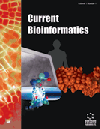- Home
- A-Z Publications
- Current Bioinformatics
- Previous Issues
- Volume 17, Issue 5, 2022
Current Bioinformatics - Volume 17, Issue 5, 2022
Volume 17, Issue 5, 2022
-
-
Differential Gene Expression in Cancer: An Overrated Analysis
More LessAuthors: Jessica Carballido and Rocío CecchiniThe search for marker genes associated with different pathologies traditionally begins with some form of differential expression analysis. This step is essential in most functional genomics' works that analyze gene expression data. In the present article, we present a different analysis, starting from the known biological significance of different groups of genes and then assessing the proportion of differentially expressed genes. Read More
-
-
-
Extended XOR Algorithm with Biotechnology Constraints for Data Security in DNA Storage
More LessBackground: DNA storage is becoming a global research hotspot in recent years, and today, most research focuses on storage density and big data. The security of DNA storage needs to be observed. Some DNA-based security methods were introduced for traditional information security problems. However, few encryption algorithms considered the limitation of biotechnology and applied it for DNA storage. The difference Read More
-
-
-
SEMCM: A Self-Expressive Matrix Completion Model for Anti-cancer Drug Sensitivity Prediction
More LessAuthors: Lin Zhang, Yuwei Yuan, Jian Yu and Hui LiuBackground: Genomic data sets generated by several recent large scale high-throughput screening efforts pose a complex computational challenge for anticancer drug sensitivity prediction. Objective: We aimed to design an algorithm model that would predict missing elements in incomplete matrices and could be applicable to drug response prediction programs. Methods: We developed a novel self-expressive mat Read More
-
-
-
COVID-19 Biomarkers Recognition & Classification Using Intelligent Systems
More LessBackground: SARS-CoV-2 has paralyzed mankind due to its high transmissibility and its associated mortality, causing millions of infections and deaths worldwide. The search for gene expression biomarkers from the host transcriptional response to infection may help understand the underlying mechanisms by which the virus causes COVID-19. This research proposes a smart methodology integrating different RNA-Se Read More
-
-
-
DSAE-Impute: Learning Discriminative Stacked Autoencoders for Imputing Single-cell RNA-seq Data
More LessAuthors: Shengfeng Gan, Huan Deng, Yang Qiu, Mohammed Alshahrani and Shichao LiuBackground: Due to the limited amount of mRNA in single-cell, there are always many missing values in scRNA-seq data, making it impossible to accurately quantify the expression of singlecell RNA. The dropout phenomenon makes it impossible to detect the truly expressed genes in some cells, which greatly affects the downstream analysis of scRNA-seq data, such as cell cluster analysis and cell development trajectories. O Read More
-
-
-
m5C-HPromoter: An Ensemble Deep Learning Predictor for Identifying 5-methylcytosine Sites in Human Promoters
More LessAuthors: Xuan Xiao, Yu-Tao Shao, Zhen-Tao Luo and Wang-Ren QiuAims: This paper is intended to identify 5-methylcytosine sites in human promoters. Background: Aberrant DNA methylation patterns are often associated with tumor development. Moreover, hypermethylation inhibits the expression of tumor suppressor genes, and hypomethylation stimulates the expression of certain oncogenes. Most DNA methylation occurs on the CpGisland of the gene promoter region. Objective: Read More
-
-
-
Promising Novel Biomarkers and Candidate Drugs or Herbs in Osteoarthritis: Evidence from Bioinformatics Analysis of High-throughput Data
More LessAuthors: Linghui Qiao, Jie Han, Guancheng Wang, Tao Yuan and Yanglin GuBackground: The most common joint illness is osteoarthritis (OA). The goal of this study was to find changes in gene signatures between normal knee joints and OA tissue samples and look for prospective gene targets for OA. Methods: The gene expression profiles of GSE12021, GSE51588, and GSE55457 were downloaded from Gene Expression Omnibus (GEO). A total of 64 samples (40 OA and 24 standard control samples) Read More
-
-
-
Distance-based Support Vector Machine to Predict DNA N6- methyladenine Modification
More LessAuthors: Haoyu Zhang, Quan Zou, Ying Ju, Chenggang Song and Dong ChenBackground: DNA N6-methyladenine plays an important role in the restriction-modification system to isolate invasion from adventive DNA. The shortcomings of the high time consumption and high costs of experimental methods have been exposed, and some computational methods have emerged. The support vector machine theory has received extensive attention in the bioinformatics field due to its solid theoretical foun Read More
-
Volumes & issues
-
Volume 20 (2025)
-
Volume 19 (2024)
-
Volume 18 (2023)
-
Volume 17 (2022)
-
Volume 16 (2021)
-
Volume 15 (2020)
-
Volume 14 (2019)
-
Volume 13 (2018)
-
Volume 12 (2017)
-
Volume 11 (2016)
-
Volume 10 (2015)
-
Volume 9 (2014)
-
Volume 8 (2013)
-
Volume 7 (2012)
-
Volume 6 (2011)
-
Volume 5 (2010)
-
Volume 4 (2009)
-
Volume 3 (2008)
-
Volume 2 (2007)
-
Volume 1 (2006)
Most Read This Month
Article
content/journals/cbio
Journal
10
5
false
en


